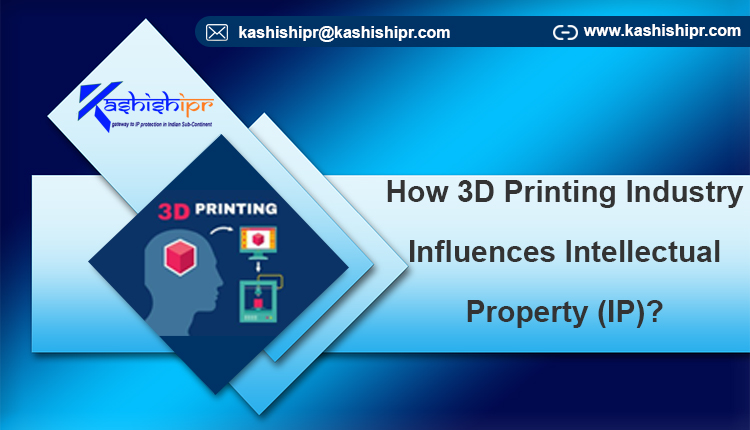How 3D Printing Industry Influences Intellectual Property (IP)?
Emerged in the 1980s, 3D technology, due to the availability of high-performance and low-cost 3D printers, has now come within the reach of not just big organizations but ordinary consumers as well. By fulfilling expectations of different types of businesses and people, it is emerging as one of the best technologies in the present rapidly advancing world. While this potentially transformative technology provides numerous opportunities to manufacturers and designers, there is a concern revolving around the impact of its increasing use on the Intellectual Property Rights (IPR).
How does the 3D printing process work?
3D printing is a technological process that builds up a three-dimensional object from a computer-aided design model, often by adding layer by layer. The process commences with a digital file, which is further exported to 3-dimensional printers by using dedicated software that transforms the digitally formatted model into a physical object. As the process includes the building of molten material by adding layer after layer, it is also known as additive manufacturing.
3D printing technology, while developing at a breath-taking pace, is making its place in various areas, including food, fashion, regenerative medicine, and prosthetics.
What are the benefits of 3D printing?
3D printing bestows innovation-intensive companies with numerous potential advantages, such as it:
- Allows the firms to decrease their expenses when designing, developing, and testing the new 3D printed products
- Enables the companies to improve the existing products
- Prevents the enterprises from paying for expensive prototypes, thus benefitting them by preserving their financial assets.
As 3D printing has changed the way that businesses were using to manufacture objects, it has a significant impact on how manufacturers protect their Intellectual Property (IP) and enforce their rights.
Intellectual Property Procurement
Companies and people that design, make, or sell 3D printers, parts, and accessories have the same opportunities to obtain Intellectual Property Protection as manufacturers and innovators in other industries. They can also copyright their creative works, patent their technology, and trademark their brands. Likewise works and products, 3D printing methods are also patentable.
Preventing unauthorized 3D printing in the IP industry
Anyone dealing with 3D printed objects is vulnerable to infringement by unauthorized individuals or firms. However, depending on the different ways of infringing, the strategies to combat violations related to 3D printing vary. Hence, the owner may require different approaches to address infringement by a customer, a competitor, or other.
- Competitors
Preventing competitors from infringing patents, copyrights, or trademarks in the 3D printing area is similar to doing the same in other sectors. But in this field, the types of intellectual property rights, like copyrights, Design Patents, etc. that can come into effect quickly may appear more valuable to defend against infringement issues.
In 3D printing, Copyright rights tend to protect the originality of the creator’s work. It means that if anyone prints copies of the original object without authorization, the creator can attain relief under Copyright Law. Furthermore, industrial designs protect the ornamental and aesthetic appearance, including the shape and form of the object, the patent safeguards its technical functionality, and the trademark enables buyers to identify its source.
Customers crafting replacement parts
‘Printing replacement parts’ is one of the main areas where infringement in regards to this technology is on the hike. Rather than purchasing from the original manufacturers or suppliers, many customers themselves print the replacement parts. Original manufacturers can prevent this by using copyrights, utility patents, etc., to protect certain replaceable parts.
People sharing infringing files
CAD files, no matter whether have been stolen or recreated; can be shared over the internet. However, the owners can prevent infringement resulting in this manner by implementing various strategies accessible for protecting intellectual property.
Trademark and copyright rights should extend to the CAD files of products that use underlying IP so that the storing and transfer of those files themselves appear as an act of infringement. In the 3D printing arena, patent rights are unlikely to cover the CAD files used to craft the objects. To overcome this weakness, manufacturers and innovators can wish to obtain Patent Protection for their files themselves. It would display the building of a stored CAD file as a direct infringement act.
Conclusion
At present, no one can clearly say how far 3D printing will have an impact on the manufacturing area. However, it is worthy to say that the owners with IP rights cannot just keep their 3D printed products safe but also have benefits of a lot of opportunities. Moreover, by being aware of the market and protecting IP, the rights holders can discover ways to generate more revenue while proceeding with the technological advancements in 3D printing. Hence, businesses should pay close attention to how this technology influences their IP rights and protection. Besides, those who are related to the industry should be cautious about not to infringe the rights of other manufacturers. For more visit: https://www.kashishipr.com/
Don’t forget to follow us on social media:
Facebook – https://www.facebook.com/kashishipr/
Twitter – https://twitter.com/kashishipr
Linkedin – https://www.linkedin.com/company/kashishipr/
Pinterest – https://www.pinterest.com/kashishipr/
Tumblr – https://kashishipr.tumblr.com/

